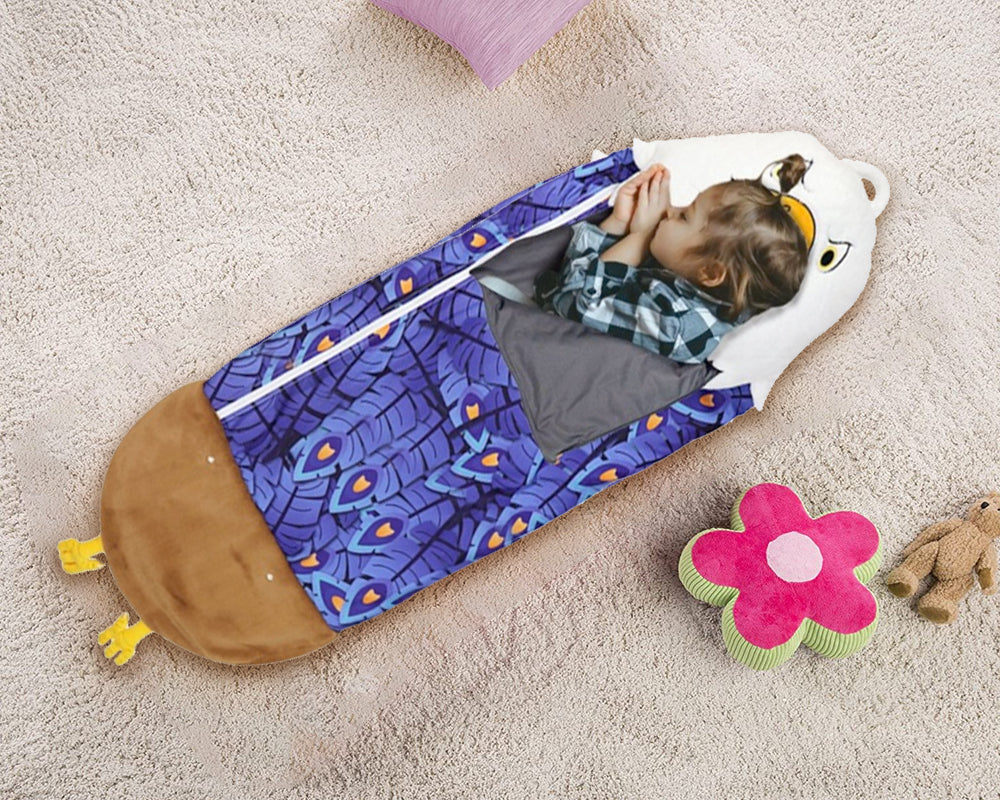Recent studies have shown many positive benefits to using a bag for sleeping. It is essentially a wearable blanket specifically designed to help them maintain the correct temperature overnight. It also eliminates the need for any additional blankets. Due to their popularity, there are many options available on the market, from newborn swaddle bags for sleeping to bags for sleeping that help children sleep independently. In this blog, we'll explore the benefits of using a child's sleeping bag, how to choose the right one, and some tips for use and care.
The benefits of it:
There are several benefits of using a kids sleeping bag for family camping trips, including:
Comfort: Childs sleeping bags are designed to provide a comfortable sleeping space for children, with soft and cozy materials that keep them warm and snug.
Warmth: Bags for sleeping provide insulation, keeping children warm during cold nights, ensuring they sleep comfortably throughout the night.
Safety: Bags for sleeping provide a safe and secure sleeping space for children, preventing them from rolling off an air mattress or getting tangled in blankets while sleeping.
Independence: Having their own bag for sleeping gives children a sense of independence and ownership over their sleeping space, making them more likely to enjoy camping and outdoor activities.
How to choose the right children's sleeping bag:
A proper bag for sleeping will allow your child to provide adequate warmth and a comfortable night's sleep. Here are some factors to consider when choosing a sleeping bag for children:
Size: The size of the bag for sleeping is crucial to ensure that your child can sleep comfortably in it. Children's sleeping bags come in different sizes, so choose the right one for your child's age, height and weight.
Materials: bags for sleeping are made of different materials such as synthetic, down and cotton. Synthetic materials are durable and easy to care for, while down provides excellent insulation. Cotton warm sleeping bags will be more comfortable.
Foldability: The foldability of the bag for sleeping will facilitate portability when going out and when storing. Lighter weight, more compact, easier to handle and easier to clean the bag for sleeping can reduce more trouble.
Price: bags for sleeping come in different price points, so choose one that fits your budget without compromising quality.
Shape: Consider the shape of the bag for sleeping. Rectangular bags for sleeping they are spacious and provide enough room for kids to move around while sleeping. Mummy bags for sleeping are designed to provide maximum warmth and insulation, making them ideal for cold climates and winter camping trips. The semi-rectangular bags for sleeping provide a balance between roominess and warmth, making them suitable for a range of temperatures. You can easily find many different styles on armadadeals.

Tips for using and maintaining it:
Using and caring for your kids sleeping bag is essential to ensure that it lasts and provides your child with the best sleep experience. Here are some tips for using and caring for childrens sleeping bag with pillow:
Use a sleeping pad: Using a sleeping pad underneath the bag for sleeping provides additional insulation and comfort, and protects the bag from the ground.
Air out the sleeping bag: After each use, air out the bag for sleeping to remove moisture and prevent mold and mildew.
Spot clean as needed: If the bag for sleeping becomes dirty, spot clean it with mild soap and water and avoid harsh chemicals.
Clean as necessary: When the bag for sleeping needs deeper cleaning, follow the manufacturer's instructions for washing and drying.
Store properly: When not in use, store the bag for sleeping in a cool, dry place.
Consider using a liner: A bag for sleeping liner can help protect your sleeping bag from dirt and sweat and add extra warmth.
Avoid overstuffing your bag for sleeping: overstuffing your bag for sleeping can cause it to lose its fluffiness and insulation, which reduces warmth and comfort.

Safety precautions for it:
Some sleeping arrangements are not safe. They can increase the risk of sudden death or accidents. So keep in mind some of the following safety precautions when using a childs sleeping bag:
Age Appropriate: Make sure the sleeping bag is appropriate for your child's age and size. For younger children, consider using a sleeping bag specifically designed for them.
Temperature Rating: Choose a sleeping bag with the right temperature rating for the climate and temperature of your camping destination. Sleeping bags that are too warm or not warm enough can pose a safety hazard.
Flammability: Make sure the bag for sleeping is kept away from open flames and heat sources.
Comfortable fit: Make sure the bag for sleeping fits snugly around your child without any extra space that could cause them to get tangled or trapped.
Zipper: Make sure the zipper is smooth and durable, so that it can be easily pulled when entering or leaving the bag for sleeping and there is no danger of hooking or hanging on clothes or skin.
Harmful substances: Avoid bags for sleeping that contain harmful substances, such as lead or phthalates.
Supervision: Always supervise your children while they are using their bags for sleeping and teach them safe sleep habits, such as staying in the bag and not playing with the zipper.
Above is all the effective information about sleeping bags for kids. With these tips and safety precautions, you can easily select the right sleeping bag for your children so as to provide them with a comfortable and safe sleeping space.



